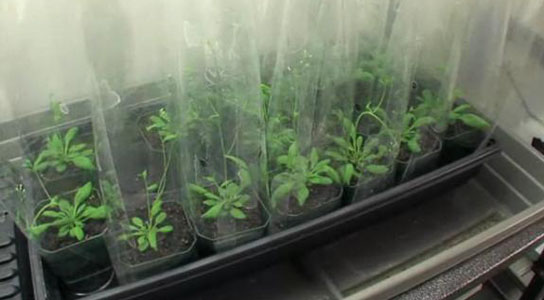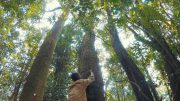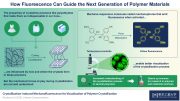Researcher Edgar Spalding from the University of Wisconsin-Madison is trying to figure out how to grow crops optimally suited to survive and thrive in all conditions. By using time-lapse video and studying the function of each of the thousands of genes that make up the plants’ DNA, Spalding hopes to gain better insight into root growth and the genes that control it.
At first, the back room of plant physiologist Edgar Spalding’s lab at the University of Wisconsin-Madison might be mistaken for an alien spaceship set straight out of a Hollywood movie. It’s a room bathed in low-red light with camera lenses pointing at strange-looking entities encased in Petri dishes.
A closer inspection reveals the Petri dishes contain nothing alien at all, but rather very down-to-earth corn seedlings. They’re grown in red light for optimal growth. They’re just one of the plants featured in thousands of time-lapse movies Spalding has created over the past five years. The goal: figure out how to grow crops optimally suited to survive, and thrive.

Botanists search for genes that would make a better root. Credit: National Science Foundation
“We can’t hope to improve a plant unless we understand it well,” says Spalding. With support from the National Science Foundation (NSF), Spalding is exploring just what makes plants tick. He says the key is to study the function of each of the thousands of genes that make up the plant’s DNA. “One way to do that is to collect images of those plants that have those genes altered in some way. And by measuring how those plants grow and develop differently,” says Spalding.
“We are able to infer the function of the gene that’s been manipulated,” he continues. Researchers have created thousands of genetically different corn plants. Spalding uses specially rigged cameras to snap pictures every 30 seconds or so of the plant’s roots as they grow.
He also uses a six-foot-high robotic camera that’s capable of shooting dozens of roots at once. “We have made hundreds of thousands of measurements from thousands of different plants. Let’s say we had a ruler, we’d probably be on number two… maybe,” he says with a chuckle. The time-lapse movies are loaded into a computer and an algorithm measures cellular growth rates in the root with pinpoint accuracy, as well as the angle and curvature of the root tip.
“By using this so-called computer vision or machine vision to track [the plants] growth and development, we can get at the genes that control root growth and those hopefully will have fundamental importance to crop improvement. It lays the foundation for discoveries that will help improve plants for human purposes.”
Spalding is sowing the seeds for better crops of the future. It’s an idea he thinks is worth growing.









It’s also worth noting that mycorrhizal fungi can help root growth by developing a secondary root system for the plant.